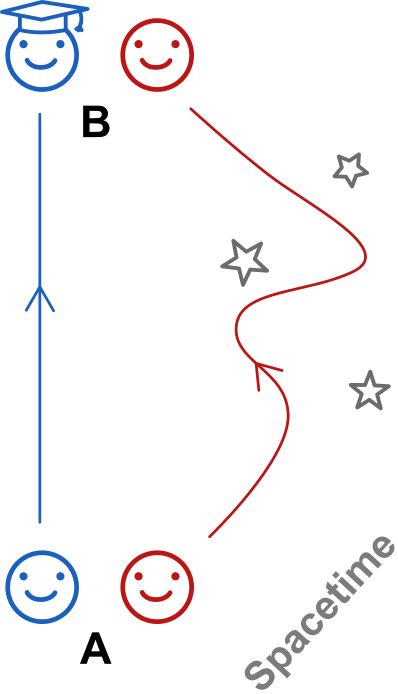When I was very young, I was presented with this challenging riddle:

Recreated as accurately as possible according to my artistic abilities
Little boy must go to the house. There are two paths. Which path is shorter?
Don't worry, we won't need the actual answer to the riddle. We just need the much weaker insight that is also part of what this image is meant to teach to children: different paths between the same starting and ending point can have different lengths.
If the boy carries a ruler, and he uses it to measures the length of the path as he follows it, he will find that the left path and the right path have different lengths. Or, unrolling a thread on the path, he will find that different amounts of thread are needed. (Guessing which path is actually shorter requires instead extremely advanced mathematical abilities and is left as an exercise for the intrepid reader, but as I said, we don't need it.)
Now, the obvious generalization.
Instead of using the page to represent space, we use it to represent spacetime:

Two twins, Blue and Red, are together at the same event A (it can be their 8th birthday at their home). They are also together at an event B, say Blue's graduation party again at home. But between A and B Blue and Red lead different lives. Blue stays home on Earth studying. Red embarks on a long trip through the Universe. They have taken different paths through spacetime.
And these paths have a duration. The time that Blue feels passing from A to B is the duration of his path, and the time that Red feels from A to B is the duration of her path. How do you measure duration more objectively? With an instrument called a clock. (Or a stopwatch, if you prefer).
The twins both start their clock at A. As they follow their own, different paths in spacetime the clocks "unroll the thread" and measure the durations of the paths until they meet again at B. They will indeed measure different values, and one of the twins will be younger, having experienced less time.
And that's it. There is no "warping" or "slowing" or "fastening" of time, just different paths which in general have different durations, just as there was no "stretching" or "squashing" of space when the little boy needed to get to the house. It was just different paths. (Nor is there any mysterious force affecting clocks or biological aging). And this is incredibly general: it works in special or general relativity in any spacetime.
Of course this does not tell you which twin is younger and by how much. It does not touch on the problem that is usually considered the paradoxical part (the question of the apparent symmetry etc etc). But often that is way too much for the layman. To many people, the fact that the twins have different ages when they meet again is the paradox!
The kind of relativistic gymnastics the average physicist (or knowledgeable mathematician) performs when asked this very simple question:
How can one twin be younger than the other? How is that possible?
is incredible. People pull out spacetime diagrams, light cones, square roots, "motion through time", vectors, four-vectors, invariant sets, acceleration, planes of simultaneity... probably because when you study relativity you meet all this stuff before the twin paradox is introduced, and mostly as an example, so one subconsciously assumes this stuff is necessary to understand the twins at the most basic level. It's really not, it's very simple.
I might even go a bit further into the opinion territory and just say that the way the whole thing is taught is backwards. Proper time is simplest, it is invariant, it is immediately observable with a clock that the observer carries, and it should be introduced first. Just like proper length and rulers. Everything else then follows, as you can map out spacetime with families of observers with clocks and rulers and construct coordinate systems, in which then you can study inertial and non inertial frames, Lorentz transformations, time dilation of any variety, relativistic beaming, whatever. Everything can be derived from proper time, because that is simply what the metric on spacetime is, and that's the actual fundamental entity in classical relativity. End of rant.

